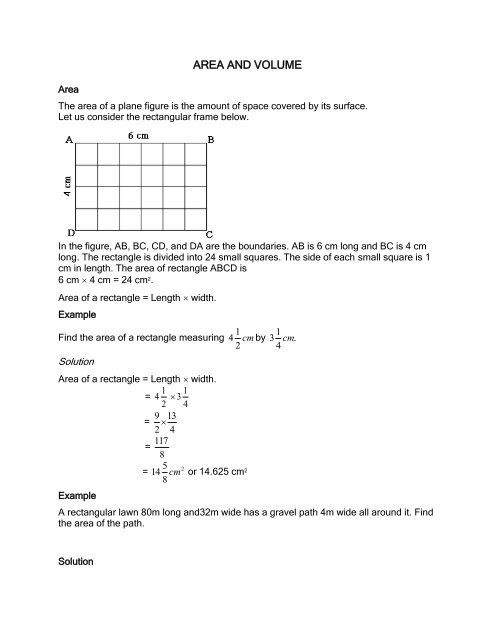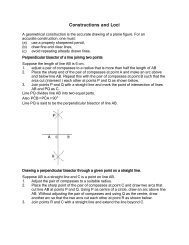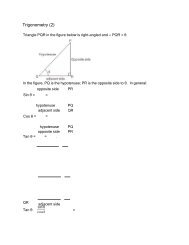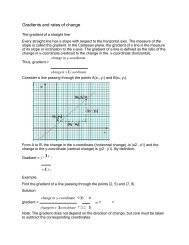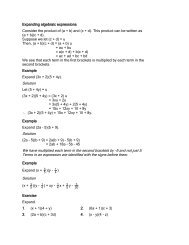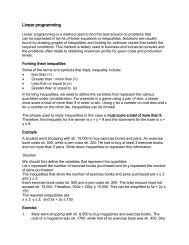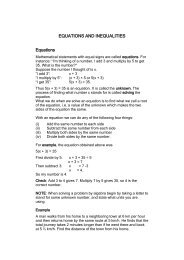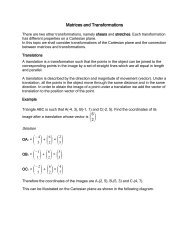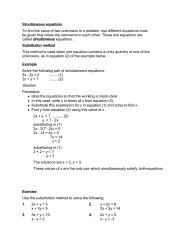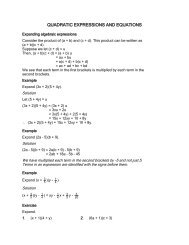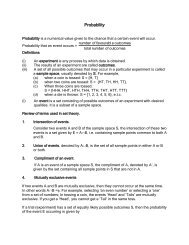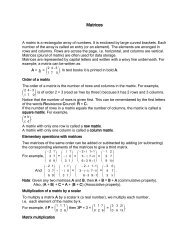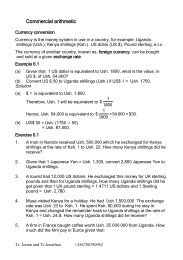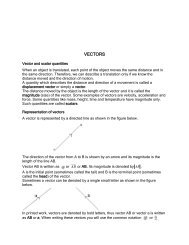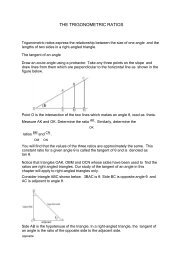J18
Create successful ePaper yourself
Turn your PDF publications into a flip-book with our unique Google optimized e-Paper software.
Area<br />
AREA AND VOLUME<br />
The area of a plane figure is the amount of space covered by its surface.<br />
Let us consider the rectangular frame below.<br />
In the figure, AB, BC, CD, and DA are the boundaries. AB is 6 cm long and BC is 4 cm<br />
long. The rectangle is divided into 24 small squares. The side of each small square is 1<br />
cm in length. The area of rectangle ABCD is<br />
6 cm 4 cm = 24 cm 2 .<br />
Area of a rectangle = Length width.<br />
Example<br />
Find the area of a rectangle measuring<br />
Solution<br />
Area of a rectangle = Length width.<br />
1 1<br />
= 4 3<br />
2 4<br />
9 13<br />
= <br />
2 4<br />
117<br />
=<br />
8<br />
5 2<br />
= 14 cm or 14.625 cm 2<br />
8<br />
Example<br />
1 1<br />
4 cm by 3 cm .<br />
2 4<br />
A rectangular lawn 80m long and32m wide has a gravel path 4m wide all around it. Find<br />
the area of the path.<br />
Solution
The area of the grass = 80 × 32m 2<br />
= 2560m 2<br />
Now the length of the whole rectangle formed by the lawn and path<br />
= (80 + 4 + 4) m = 88m<br />
The width = (32 + 4 + 4) m<br />
= 40m<br />
The total area = 88 × 40m 2 = 3520m 2<br />
The area of the path = (3520 – 2560) m 2 = 960m 2 .<br />
32 m<br />
80 m<br />
4 m<br />
Method ii<br />
The path can be divided up into two rectangles each 88m by 4m, together with two more<br />
rectangles, each 32m by 4m.<br />
The area of the path = (2 × 88 × 4 + 2 × 32 × 4) m 2<br />
= (704 + 256) m 2<br />
= 960m 2 .<br />
Area of combined rectangles<br />
When the corners of a plane figure are right angles, the area is found by dividing it into<br />
rectangles as shown below.<br />
Area of rectangle A = 2 1.5 = 3 cm 2<br />
Area of rectangle B = 2 1 = 2 cm 2<br />
Area of rectangle C = 3 1 = 3 cm 2<br />
When working out problems involving areas, the following points should be notd.
1. Measurements must be in the same units. For instance, if length is in centimeters,<br />
width must also be in centimeters.<br />
2. Linear measure linear measure = square measure.<br />
3. Square measure linear measure = linear measure.<br />
Converting units of area<br />
The units of area are: millimeter squared (mm 2 ), centimeter squared (cm 2 ), decimeter<br />
squared (dm 2 ), metre squared (m 2 ), Dekametre squared (Dm 2 ), hectometer squared<br />
(hn 2 ), and kilometer squared (km 2 ).<br />
The conversion flow chart on the next page can be used to change one to another. For<br />
instance, to change a smaller unit of area to a larger unit area, use the arrows on the<br />
right side.. Conversely, to change a larger unit of area to a smaller unit use the arrows<br />
on the left side. Thus an area of 1000 cm 2 = (1000 100) dm 2 = 10 dm 2 an<br />
1000 cm 2 = (1000 100) mm 2 = 100 000 mm 2 .<br />
Similarly an area of 1 km 2 = (1 100 100 100) m 2 .<br />
Exercise<br />
1. The figure below represents a rectangular table top. Find the area of the shaded<br />
part given that the width of the shaded part is 5 cm all round.<br />
2. A rectangular piece of land measuring 100 m by 90 m has an area of 40 m by 80 m<br />
planted with beans and another area of 30 m by 30 m planted with simsim. The rest<br />
of the land has maize. Find the area under maize.<br />
3. The diagonal of a square is 2.42 cm. Find the area of the square.<br />
4. Convert each of the following to the units in the brackets.<br />
(a) 45 m 2 (cm 2 ) (b) 15 km 2 (m 2 ) (c) 4650 m 2 (km 2 )
mm 2<br />
100<br />
100<br />
cm 2<br />
cm 2<br />
100<br />
100<br />
cm 2<br />
dm 2<br />
100<br />
100<br />
cm 2<br />
m 2<br />
100<br />
100<br />
cm 2<br />
Dm 2<br />
100<br />
100<br />
cm 2<br />
hm 2<br />
100<br />
100<br />
km 2
Area of a triangle<br />
A triangle is a geometrical figure with three sides and three angles.<br />
The figure below shows rectangle ABCD divided into two equal triangles. Thus, area of<br />
triangle ADC = area of triangle ABC.<br />
In triangle ADC, AD is the perpendicular height (h) and DC is the base (b). In triangle<br />
ABC, BC is the height an d AB is the base.<br />
2 area of triangle ABC = area of rectangle ABCD.<br />
Area of rectangle ABCD = h b.<br />
Therefore, area of triangle ABC<br />
= 2<br />
1 area of rectangle ABCD.<br />
= 2<br />
1 h b<br />
= 2<br />
1 bh.<br />
Area of any triangle = ½ × base × perpendicular height.<br />
Example<br />
Find the area of triangle PQR in the figure below.<br />
Area of triangle PQR = Area of triangle QRS – Area of triangle PRS<br />
= 2<br />
1 8 4 - 2<br />
1 2 4<br />
= 16 – 4<br />
= 12 cm 2 .<br />
Alternatively, the area of triangle PQR = 2<br />
1 bh = 2<br />
1 6 4 = 12 cm2 .
Area of a parallelogram<br />
A parallelogram is a quadrilateral with opposite side that are parallel and equal in length.<br />
The figure below shows a parallelogram PQRS. PQ is parallel and equal to SR while PS<br />
is parallel and equal to QR.<br />
In the figure, h is the height of triangle PQR and PRS. PQ is the base of triangle<br />
PQR = SR = b (the base of the triangle PRS). The area of parallelogram PQRS = area<br />
of triangle PRS + area of triangle PQR.<br />
Area of parallelogram PQRS<br />
= ( 2<br />
1 b h) + ( 2<br />
1 b h) = bh.<br />
Note that h is the perpendicular distance between the parallel sides.<br />
Example<br />
Find the area of a parallelogram whose base and height are 5 cm and 8 cm respectively.<br />
Solution:<br />
Area of parallelogram = base height<br />
= 5 cm 8 cm<br />
= 40 cm 2 .<br />
The above formula is also used for finding the area of a rhombus, which is a special<br />
parallelogram with all its sides equal in length and diagonals meeting at right angles.<br />
Area of a trapezium<br />
A trapezium is a quadrilateral with only two sides that are parallel. The figure below<br />
shows a trapezium in which AB is parallel to DC and the lengths of AB and DC are a<br />
and b respectively. Let the perpendicular distance between the parallel sides be h.<br />
When line AC is drawn, trapezium ABCD is divided into two triangles ABC and ACD.
Area of trapezium ABCD<br />
= Area of triangle ABC + Area of triangle ACD<br />
= 2 1 a h + 2 1 b h<br />
= 2<br />
1 ah + 2<br />
1 bh<br />
= 2<br />
1 h(a + b).<br />
Note that (a + b) is the sum of the lengths of the parallel sides. Thus, the area of a<br />
trapezium is equal to 2<br />
1 (perpendicular distance between parallel sides) sum of the<br />
parallel sides. Therefore, the area of a trapezium is 2<br />
1 h(a + b) where h = perpendicular<br />
height,<br />
a = length of shorter side and b = length of longer parallel side.<br />
Example<br />
Find the area of the trapezium in the figure below.<br />
Solution:<br />
Perpendicular height = 5 cm<br />
Sum of parallel sides = (4 + 9) cm<br />
= 13 cm<br />
Area = 2<br />
1 5 13<br />
= 32.5 cm 2
Exercise<br />
1. Find the area of each of the following figures.<br />
(a) (b) (c)<br />
2. A right-angled triangular sheet of metal has its hypotenuse measuring 1.7 m and<br />
the base 1.5 m. Find the area of the sheet of metal.<br />
3. A triangle has an area of 10.5 cm 2 and a perpendicular height of 3 cm. Find the<br />
length of the base.<br />
4. Find the area of parallelogram ABCD.<br />
5. The length of a rhombus is 13 cm and its longer diagonal is 24 cm. Find the area of<br />
the rhombus.<br />
6. The area of a parallelogram is 15.4 cm 2 . If its height is 7 cm, find its base.<br />
7. The parallel sides of a trapezium are 9.5 cm and 4.5 cm respectively. If the<br />
perpendicular distance between the parallel sides is 5 cm, find the area of the<br />
trapezium.<br />
8. The area of a trapezium is 16.5 cm 2 and the parallel side are 6.5 cm and 4.5 cm<br />
respectively. Find the perpendicular height between the parallel sides.<br />
9. A trapezium has an area of 25.5 cm 2 and a perpendicular height of 6 cm. If the<br />
length of one of the parallel sides is 5 cm, find the length of the other parallel side.<br />
10. Find the area of the shapes below.<br />
(a)<br />
(b)
(c)<br />
(d)<br />
(e)<br />
11. A rectangular table top measures 1.2 m by 80 cm. Find the area of the table top<br />
in square metres.<br />
12. The length of a rectangular plot is 200 m. If the area of the plot is 4800 m 2 , find<br />
the width of the plot.<br />
13. A room 5.5 m long and 4.2 m wide has a carpet in the middle. If a margin of 20<br />
cm wide is left all round, find the area of the floor that is not covered by the<br />
carpet.<br />
14. A photograph 20 cm wide and 30 cm high is mounted on a cardboard so that<br />
there is a margin 2 cm wide at the top and at the bottom. A margin of 1.5 cm is on<br />
both the left and the right sides. Calculate the area that is not covered by the<br />
photograph.<br />
15. Find the area of the shaded part given that PQRS is a rhombus, PQ = 13 cm, TR<br />
= 2 cm and QS = 10 cm.
16. The area of a rhombus is 240 cm 2 . If the length of one of the diagonals is 16 cm,<br />
find the length of the rhombus.<br />
17. The area of quadrilateral PQRS is 54 cm 2 . If the area of PRS is 20 cm 2 , find the<br />
value of h if PR = 10 cm.<br />
Area of a circle<br />
The figure below shows a circle of radius r. It is divided into 8 equal sectors. The sectors<br />
are cut out and then arranged to form a parallelogram. The curved lines of adjacent<br />
sectors are placed opposite each other as shown below. The dotted line shows the<br />
height of the parallelogram which is equal to the radius r. The base of the parallelogram<br />
is equal to r, that is, half the circumference of the circle.<br />
Circumference of a circle = 2 r<br />
Area of a parallelogram = base height<br />
= r r = r 2<br />
Thus, the area of any circle = r 2 , where r is the radius and = 22<br />
7<br />
or 3.142 (correct to 3<br />
d.p.)
Example<br />
Find the area of a circle whose radius is 7 cm.<br />
Solution<br />
Area = r 2 =<br />
22<br />
7 7 7 = 154 cm2 .<br />
Area of a sector of a circle<br />
A sector is a part of a circle enclosed by two radii and an arc (minor or major). The figure<br />
below shows the major and minor sectors of a circle.<br />
If the angle subtended by the major arc at the centre is , then the area of the major<br />
2<br />
sector = .<br />
360<br />
r<br />
Example<br />
A circle has a radius of 18 cm. Find the area of a sector of the circle whose arc subtends<br />
an angle of 70 0 at the centre. (Take = 7<br />
22 ).<br />
Solution<br />
Area of a sector =<br />
2<br />
360 r<br />
=<br />
<br />
<br />
<br />
70<br />
360<br />
22<br />
7<br />
<br />
cm<br />
<br />
2<br />
18<br />
18<br />
= 198 cm 2 .
Exercise<br />
1. Calculate the areas of the circles of radii:<br />
(a) 1.4 m, (b) 4.2 cm. (Take = 7<br />
22 )<br />
2. Calculate the area of the sector of a circle when:<br />
(a) radius = 14 cm, angle of sector = 50 0 .<br />
(b) radius = 21 cm, angle of sector = 22.5 0 .<br />
(Take = 3.142).<br />
3. Calculate the angles at the centre of the circle if the areas of the sectors and the<br />
radii are as follows:<br />
(a) area = 3.698 cm 2 , radius = 2.8 cm<br />
(b) area = 28.14 cm 2 , radius = 7 cm<br />
(c) area = 31.4 cm 2 , radius = 6 cm<br />
4. A circular metal sheet of radius 3.5 cm was cut out from a rectangular metal sheet<br />
measuring 8 cm by 9 cm. Find the area of the metal left.<br />
5. The figure below shows a square plate whose side measures 15 cm. Four squares<br />
each of side x cm have been cut out. If the perimeter of the square plate after the<br />
small squares are cut out is 84 cm, find the area of the plate left.<br />
6. Calculate the area of the shaded region in the following<br />
shapes.<br />
(a)<br />
(b)<br />
Area of irregular plane figures
So far we have learnt how to find areas of regular plane figures. In this section we will<br />
discuss how to find areas of irregular plane figures. The figures are drawn on a grid<br />
whose scale is known. However, the areas obtained are approximations. In order to find<br />
the area of any irregular plane figure, the following steps must be followed.<br />
Step 1. Count the number of whole squares enclosed within the figure.<br />
Step 2. Count all the incomplete squares covered by the figure and divide the total by<br />
two.<br />
Step 3. Add the values obtained in steps 1 and 2 together and then multiply the total<br />
sum by the area of one square. The value obtained is the estimated area.<br />
Example<br />
Estimate the area of triangle PQR which is drawn on 1 cm squares.<br />
Solution<br />
Number of whole squares = 12<br />
Number of incomplete squares = 8<br />
Total number of squares<br />
8<br />
= 12 +<br />
2<br />
= 16<br />
Area of triangle PQR = 16 1 cm 2 = 16 cm 2<br />
Note that triangle PQR is a regular plane figure and its area can be<br />
calculated using the following formula<br />
1<br />
Area = base height<br />
2<br />
In this case,<br />
Area =<br />
Example<br />
1<br />
8 4 = 16 cm<br />
2<br />
2<br />
An outline of a swamp is drawn on a 1 cm square paper as shown in the figure below.
Estimate the area of the outline in cm 2 .<br />
Solution<br />
Number of whole squares = 11<br />
Number of incomplete squares = 16<br />
16<br />
Total number of squares = 11 + = 19<br />
2<br />
Area of outline = 19 1 cm 2<br />
= 19 cm 2 .<br />
Exercise<br />
Estimate the area of the following irregular figures drawn on 1 cm<br />
squares.<br />
1. 2. 3.<br />
Surface area of solids<br />
A solid is a shape formed in a 3-dimensional space. The most<br />
common of these are the cube, cuboid, cylinder, cone, pyramid,
prism and sphere. The surface area of any solid is equal to the sum<br />
of the areas of all the faces.<br />
Surface area of a cube<br />
A cube has six equal faces. The area of each face = l l. The<br />
surface area of the whole cube = 6(l l) = 6l 2<br />
Example<br />
Calculate the surface area of a cube whose length is 6 cm.<br />
Solution<br />
Surface area = 6l 2 cm 2<br />
= 6 6 6 cm 2<br />
= 216 cm 2 .<br />
Surface area of a cuboid<br />
The figure below shows a cuboid of length l, breadth b and height h.<br />
h<br />
b<br />
l<br />
A cuboid has 3 pairs of faces of different sizes. Therefore, surface area<br />
= 2 (l b) + 2 (l h) + 2 (b h)<br />
= 2(lb + lh + bh)<br />
Example<br />
Find the surface area of a cuboid measuring 6 cm by 4 cm by 3 cm.<br />
Solution
Surface area = 2(lb + lh + bh)<br />
= 2 (6 4 + 6 3 + 4 3)<br />
= 2 54<br />
= 108 cm 2 .<br />
Surface area of prisms<br />
A prism is a geometric solid having 2 faces that are identical and parallel to each other.<br />
Any plane cut, made parallel to the ends, produces a cross-section of the same shape<br />
and size as the ends. Prisms are named after the shape of the cross-section, for<br />
example, a triangular prism has a triangular end and a hexagonal prism has a<br />
hexagonal cross-section.<br />
The ends of a prism are parallel and are of the same size while the faces are<br />
parallelograms.<br />
A prism is said to have a cross-section of uniform area. Different types of prisms are<br />
shown below.<br />
To find the surface area of a prism, the following steps should be followed.<br />
1. Identify the shape of the face, for example, square, rectangle, triangle,<br />
parallelogram and trapezium.<br />
2. Find the area of each face using a suitable formula.<br />
3. Add the areas of all the faces together.<br />
Example<br />
Calculate the surface area of the prism below.
Solution<br />
Area of triangular faces = 2 <br />
1 2<br />
4 3<br />
cm 2<br />
= 12 cm 2<br />
Area of rectangular faces<br />
= (4 8) + (5 8) + (3 8)<br />
= 32 + 40 + 24<br />
= 96 cm 2<br />
Total surface area = (96 + 12) cm 2<br />
= 108 cm 2<br />
Surface area of a cylinder<br />
A cylinder is a prism with a circular cross-section. In the figure below we notice that a<br />
cylinder has one curved surface and two circular surfaces at the two ends. Assume the<br />
height and radius of the cylinder are h and respectively.<br />
When the two circular faces of a cylinder are removed and then the curved surface is cut<br />
along the vertical dotted line, see figure (i), a rectangular face is obtained and its<br />
measurements are shown in figure (ii). Note that the circumference of the circular edge<br />
becomes the length of the rectangular surface, hence our representation of the length<br />
as 2r, the formula for the circumference of a circle.<br />
The surface area of the curved surface = 2rh.<br />
And the area of the circular ends = 2 r 2<br />
The surface area of a closed cylinder = 2rh + 2r 2<br />
The surface area of an open cylinder (with one end closed)<br />
= 2rh + r 2 .<br />
Exercise
1. Calculate the surface areas of each of the following shapes.<br />
(All measurements are in cm).<br />
(a).<br />
(b).<br />
2. A water gutter was made from a thin sheet of metal in the shape shown below.<br />
Calculate the area of the sheet of metal used.<br />
3. An open cylindrical tank has a diameter of 4.2 m and a height of 2 m. Calculate the<br />
surface area of the curved surface.<br />
4. The height of a cylindrical tin is 15 cm. The area of the curved surface is 330 cm 2 .<br />
Find the radius of the tin.<br />
5. A large-scale farmer spent sh. 200,000 on land preparation per square kilometer. If<br />
the farmer planted wheat on 0.2 km 2 , maize on 0.2 km 2 and barley on 0.1 km 2 ,<br />
calculate the amount of money spent by the farmer.<br />
6. A rectangular block is 6cm long, 3cm wide and 2cm high. Find the total area of the<br />
six faces.<br />
7. The width of a rectangle is 7cm and the perimeter is 38cm. Find the length of the<br />
rectangle and its area.<br />
8. The perimeter of a square is 48m. Find its area.<br />
9. A rectangle is 3x m long and 7m wide. Find its area and perimeter.<br />
10. A photograph 10cm by 8cm is mounted on a piece of cardboard which is 16cm by<br />
12cm. Find the area of the margin round the photograph.
Volume<br />
Volume and capacity<br />
Volume is the amount of space occupied by a shape or how much<br />
space is contained within the shape<br />
Volume of a cuboid<br />
Volume = length × breadth × height.<br />
Note that the units used for the three dimensions must be the same.<br />
Converting units of volume<br />
The units of volume are based on the units of length, that is mm, cm,<br />
m, and km.<br />
Hence the corresponding units if volume are mm 3 , cm 3 , m 3 , and km 3<br />
respectively.<br />
Note that a cube of side 1 cm has a volume of 1 cm 3 , that is,<br />
Volume = 1 cm 1 cm 1 cm = 1 cm 3
To convert cubic centimeters to cubic meters, remember that:<br />
1 cm = 10 mm<br />
1 cm 3 = 1 cm 1 cm 1 cm<br />
= 10 mm 10mm 10mm = (10 10 10) mm 3<br />
1cm 3 = 1000 mm 3<br />
Similarly, to convert cubic meters to cubic centimeters:<br />
Example<br />
1 m = 100 cm<br />
1 m 3 = 1 m 1 m 1 m<br />
= 100 cm 100 cm 100 cm<br />
= 1000 000 cm 3 .<br />
Convert the following measurements to cm 3 .<br />
(a) 20 mm 3 (b) 0.015 m 3<br />
Solution<br />
(a) 1000 mm 3 = 1 cm 3<br />
20 mm 3 3<br />
= 20<br />
1000 cm<br />
= 0.02 cm 3<br />
(b) 1 m 3 = 1000000 cm 3<br />
0.015 m 3 = 0.015 1000000 cm 3<br />
= 15 000 cm 3<br />
Remember: To convert from larger units to smaller units we multiply, while to convert<br />
from smaller units to larger units we divide.<br />
Example<br />
Find the volume of a cuboid 8 cm by 7 cm by 3 cm.<br />
Volume = 8 × 7× 3cm 3<br />
= 168 cm 3 .<br />
Example<br />
Calculate the volume of a cuboid measuring 2 m by 50 cm by<br />
110 mm. Give your answer in : (a) cm 3 (b) m 3<br />
Solution<br />
(a) Change all measurements to cm:<br />
Length = 2 m = 2 × 100 cm = 200 cm<br />
Width = 50 cm<br />
Height = 110 mm = 11 cm<br />
Volume = 200 × 50 × 11 cm 3 = 110 000 cm 3
(b) Change all the measurements to metres:<br />
Length = 2 m<br />
Width = 50 100 m = 0.5 m<br />
Height = 110 1000 m = 0.11 m<br />
Volume = 2 × 0.5 × 0.11 m 3 = 0.11 m 3<br />
Note that the answer in (b) can also be obtained from the answer in<br />
(a) thus, 1 m 3 = 1000 000 cm 3<br />
110 000 cm 3 1000 000 = 0.11 m 3<br />
Volume of a cylinder<br />
A cylinder is like a prism with a circular cross-section or it may<br />
simply betaken as a circular prism. In the figure below the<br />
cross-section of the cylinder is shaded.<br />
Volume = area of cross-section × length.<br />
= area of circular end × height.<br />
However, cylinders usually stand on their base and therefore, we<br />
often use height rather than length, that is, the volume of a cylinder<br />
with a circular end, radius r and height h is given by the formula,<br />
volume = area of circular end × height<br />
= r 2 h.<br />
Example<br />
Find the volume of a cylinder whose radius is 7 cm and height 5 cm.<br />
Solution<br />
22<br />
Area of cross-section = r 2 = 7 7 = 154 cm 2<br />
7<br />
Volume = 154 cm 2 × 5 cm = 770 cm 3<br />
The volume of a pyramid<br />
Since there are three pyramids that make up a cube, then the<br />
volume of each Pyramid is<br />
1<br />
V base area × perpendicular height<br />
3<br />
The same formula is used to find the volume of a pyramid with a base of any shape. The<br />
height of the pyramid must be vertical from the vertex and perpendicular to the<br />
horizontal base.
Example<br />
Find the volume of the pyramid given below.<br />
Solution<br />
Area of the base = 4 × 3 = 12 cm 2 . Perpendicular height = 5 cm<br />
Volume =<br />
3<br />
1 × 12 × 5 = 20 cm2 .<br />
The volume of a cone<br />
A solid cone is a pyramid with a curved surface and a circular base.<br />
1 1<br />
The volume of a cone = × base area × height = r2 h.<br />
3 3<br />
Example<br />
Find the volume of the cone in the figure below.<br />
Solution<br />
22<br />
The base area = 7<br />
7 = 154 cm 2 ; height = 10 cm<br />
7<br />
Volume = 154 × 10 = 1540 cm 3
Note: The surface area of a solid cone = area of curved surface + area of circular base<br />
and is given by the formula:<br />
S.A = rl + r 2 = r(l + r), where l is the slant height and r is the base radius.<br />
The volume of a frustum<br />
When a sector of a cone is cut off in such a way that the cut is parallel to the base, the<br />
remaining sector between the cut and the base is called a frustum.<br />
The part cut off at the top is similar to the original cone. The volume of the frustum is<br />
found by subtracting the volume of the part cut off from the volume of the original cone.<br />
The volume of a sphere<br />
The volume of a sphere of radius r is given by the formula<br />
4 V r 3<br />
3<br />
Volume of a hemisphere of radius, r, is given by the formula<br />
1 4 3 <br />
V = r <br />
2 3 <br />
Capacity<br />
The capacity of a container is the volume of liquid it can hold. There<br />
are special units for measuring capacity and the most common is<br />
the litre (l). Others include: centiliter, milliliter etc.<br />
conversion of units of capacity.<br />
10 millilitres (ml) = 1 centilitre (cl)<br />
10 cl = 1 dl<br />
10 dl = 1 litre (l)
1000 ml = 1 litre<br />
Since capacity can be obtained from volume, there is a relationship<br />
between the units of measuring capacity and the units of measuring<br />
volume, thus:<br />
1 litre = 1000 cm 3<br />
1 millilitre = 1 cm 3<br />
1000 litres = 1 m 3<br />
Example<br />
How many litres of milk will a tank measuring 3m long, 2 m wide and<br />
1 m deep hold?<br />
(Assuming the measurements given are internal measurements).<br />
Solution<br />
Volume = 6 m 3<br />
1 m 3 = (100 × 100 × 100) cm 3<br />
6 m 3 = 6 000 000 cm 3<br />
1000 cm 3 = 1 litre<br />
6 000 000 cm 3 = 6000000 1l<br />
= 6 000 l<br />
1000<br />
Exercise<br />
1. What is the height of a rectangular block which is 5m long, 3m wide and has a<br />
volume of 30 m 3 ?<br />
2. A tank is 2.5 m long and 1.8 m wide. How much does the water level rise if 540<br />
litres of water are poured in?<br />
3. A rectangular tank 2 m long and 1.62 m wide contains water to a depth of 75 cm.<br />
The water is transferred to an empty tank which is 1.5 m long and 1.2 m wide.<br />
Find the depth of the water.<br />
4. A classroom is 9.6 m long, 8.4 m wide and 3 m high. Find how many pupils can<br />
be accommodated in the room if each is allowed 0.5 m 3 of air space.<br />
5. A sheet of cardboard is a rectangle 24 cm by 16 cm. Equal squares of side 4 cm<br />
are cut out of each corner and a tray is formed by folding along the dotted lines.<br />
Find in cm 3 , the capacity of the tray.
6. A bottle contains 2 litres of water. How many cubic centimeters of water remain<br />
when 715 cm 3 is poured out?<br />
7. A drum of uniform cross-section holds 240 litres of petrol. The area of the crosssection<br />
is 1200 cm 2 . Calculate the height of the drum in metres.<br />
8. A tank is 2m long, 1.5 m wide and 2 m deep. It contains water to a depth of 25<br />
cm. How many litres of water should be added to make the tank half full?<br />
9. A bottle contains exactly 1 litre of water. All the water is poured into a rectangular<br />
container that is 10 cm long, 8.4 cm wide and 9 cm high. Will any of the water<br />
spill over, and if so, how much?<br />
10. A tank has a base area of 1.2 m 2 . Water flows from a tap into the tank at the rate<br />
of 60 litres per minute. What will be the height of the water in the tank after 60<br />
minutes?<br />
11. One litre of milk is poured into a cylindrical jug of radius 6 cm. Calculate the depth<br />
of the milk in the jug.<br />
12. Find the volume of the soil removed after digging a water tank that is 4 m deep, 3<br />
m long and 2.5 m wide.<br />
13. Find the volume of the plastic used to make a pipe 3 m long with internal and<br />
external radii of 7 cm and 8 cm respectively. Take = 3.14.<br />
14. A tin has a square base whose sides measure 20 cm. The vertical sides are 5 cm<br />
high. Cake mixture is poured into the tin and leveled off at the 3 cm mark above<br />
the base. Find the:<br />
(a) capacity of the tin.<br />
(b) volume of the cake mixture in the tin.<br />
15. Find the height of a rectangular room that measures 4.7 m long and 3.2 m wide, if<br />
the space within it is 33.84 m 3 .<br />
ANGLES<br />
ANGLES AND BEARINGS<br />
An angle is how much something has turned. The most common units for measuring<br />
angles is ‘degrees’. We can measure angles using a protractor which is marked in<br />
degrees. The degree is further subdivided into 60 minutes and each minute into 60<br />
seconds.<br />
1 right angle = 90 degrees (90 0 )<br />
1 degree = 60 minutes (60')<br />
1 minute = 60 seconds (60")<br />
Notice that seconds and minutes of angle measurement resemble seconds and minutes<br />
of time.
(a) Naming angles.<br />
If you are standing at O and facing in the direction OA, the amount of turning which you<br />
have to make before you are facing in the direction OB is called the angle between OA<br />
and OB. O is called the vertex of the angle, OA and OB are called arms of the angle.<br />
B<br />
A<br />
O<br />
The angle above is named as angle AOB or BOA abbreviated as AOB . We can also<br />
name
(d) Drawing angles<br />
To make an angle of any given size at a point P in a line AB, place the protractor with<br />
the centre O at P, and the 0 0 – 180 0<br />
line of the protractor along AB. Make a very small dot at the edge of the protractor<br />
against the necessary graduation, at Q, say. Join QP.<br />
Exercise<br />
1 Using a ruler, draw on your paper a fairly large triangle and measure the number<br />
of degrees in each angle. Make a list of the sizes of the angles, and add them<br />
together.<br />
2 Draw the angle ABC which is 62 0 . Make AB = 5 cm long and<br />
BC = 6.5 cm long. Draw AC. How long is it?<br />
3. Draw angle DEF = 41 0 with DE = 38 mm and EF = 62 mm. Find the length of DF.<br />
Definitions<br />
- Adjacent angles.<br />
These are angles that lie next to one another. E.g. angles AOB and BOC.<br />
C<br />
a<br />
B<br />
O<br />
b<br />
A<br />
In the above figure, if the two angles AOB and BOC are equal, OB is said to bisect angle<br />
AOC, or to be the bisector of angle AOC<br />
- Adjacent angles on a straight line are supplementary i.e. their sum is two right<br />
angles (180 0 ).
B<br />
C<br />
b<br />
O<br />
a<br />
A<br />
- If two straight lines intersect, four angles are formed. The two angles that are<br />
opposite each other are called vertically opposite angles. Vertically opposite angles are<br />
equal.<br />
Angles AXP, BXQ are called vertically opposite angles.<br />
Q<br />
B<br />
B<br />
X<br />
A<br />
P<br />
- Angles whose sum is 90 are called complementary angles.<br />
Exercise<br />
1. In the figure shown, x = 42 0 . ABC is straight line. Find y.<br />
A<br />
y<br />
B<br />
x<br />
C<br />
2. In the figure below AOB is a straight line and OX bisects angle AOC. If angle<br />
AOX = 62 0 , calculate angle BOC.<br />
X<br />
C<br />
A<br />
O<br />
B
3. In the figure below, OA is the bisector of angle POX and OB is the bisector of<br />
angle YOQ, and angle POX = 40 0 , calculate angles POA, POY and YOB.<br />
4. In the figure below, find x.<br />
Properties of parallel lines<br />
Meaning of Parallel lines:<br />
These are lines in one plane which do not meet and they have the property that they are<br />
everywhere the same distance apart.<br />
N<br />
Y<br />
B<br />
x<br />
A<br />
y<br />
X<br />
In the figure above, AX and BY are parallel lines. The line NBA cutting the parallel lines<br />
at A and B is called a transversal. Angles NBY, BAX are called corresponding angles.<br />
The angles x and y are called alternate angles.<br />
- corresponding angles are equal.<br />
- Alternate angles are equal.<br />
Interior angles
The figure below shows a pair of shaded angles on the same side of a transversal and<br />
lying between the parallel lines. This is a pair of interior angles. These interior angles<br />
are supplementary angles.<br />
Example<br />
1. Find angles s and t in the diagram.<br />
t<br />
s<br />
75 0<br />
Solution<br />
s and 75 0 are vertically opposite angles<br />
so s = 75 0 .<br />
t and 75 0 are corresponding angles<br />
so t = 75 0 .<br />
Exercise<br />
1. Find the angles marked a and b in the diagram.<br />
a<br />
140 0<br />
b<br />
2. In the figure below if a = 27 0 , and b= 56 0 , calculate angle BCX, XCD and BCY.
B<br />
a<br />
A<br />
X<br />
D<br />
b<br />
C<br />
Y<br />
E<br />
3. In the diagram, if AB is parallel to DC and AD is parallel to BC, and b = 61 0 .<br />
Calculate a, c and d.<br />
4. In the figure BCD is a straight line. a = 50 0 and b = 35 0 . Calculate angles XCD,<br />
ACX and ACB.<br />
Find the size of the angles marked with letters.<br />
5. 6.<br />
a<br />
108 0<br />
b<br />
a<br />
y<br />
x<br />
a<br />
40 0 70 0<br />
7. 8.
35 0<br />
x<br />
57 0<br />
9. 10.<br />
28 0 5y<br />
120 0<br />
e 136 0 3y<br />
Scale drawing<br />
In representing real length of say, a plot whose dimensions are 16 m by 8 m, on paper,<br />
we use a scale. This means that a small length on paper represents a large length on<br />
ground. This representation is called a scale drawing of the real area. For example, the<br />
figure below is a scale drawing of a rectangular field whose measurements are 16 m by<br />
8 m.<br />
The measurements of the scale drawing are 8 cm by 4 cm. This means that<br />
1 cm represents 2 m. This is the scale used to draw the plan of the field on paper.<br />
When making an accurate scale drawing, state what it is. Do not write any thing on the<br />
accurate diagram except letters marking points, as in your sketch. When asked for some<br />
particular length, the answer you give should be the actual length required and not the<br />
scaled length.<br />
Indicating scale<br />
There are 4 main ways of indicating the scale used.<br />
1. Statement scale: 1 cm represents 100km is a statement of the scale that means 1<br />
cm on the scale drawing represents 100 km on the ground.<br />
2. Linear scale: A line is drawn and then divided into equal divisions, for example,<br />
divisions of 1 cm. see figure below. Against the linear scale the real distance on<br />
the ground is indicated, in this case kilometers. This means 5 cm on the map<br />
400<br />
represent 400 km on the ground, or 1 cm on the map represents = 80 km.<br />
5
3. Ratio form: 1:100 means 1 cm represents 100 cm. The units in the scale in ratio<br />
form must be the same.<br />
4. Representative fraction: (RF): A ratio scale such as 1:1000 may be written as a<br />
1<br />
representative fraction as . The units in the scale must be the same.<br />
1000<br />
One type of scale can be converted to another.<br />
Example<br />
A scale is given in statement form as 1 cm represents 3 km. write this scale in ratio form.<br />
Solution<br />
Scale in ratio form must have the same units. We therefore convert 3 km to centimeters.<br />
3 km = 3 1000 100 = 300 000 cm.<br />
Therefore 1 cm represents 300 000 cm.<br />
In ratio form, the scale is 1:300 000.<br />
Example<br />
1<br />
A scale is given as<br />
2000<br />
in representative fraction (RF) form. What is this scale in<br />
statement form?<br />
Solution<br />
1<br />
The scale means 1 cm represents 2000 cm in statement form. This is the same as<br />
2000<br />
2000<br />
1 cm represents m = 20 m, i.e. 1 cm represents 20 m.<br />
100<br />
Example<br />
On a map whose scale 1:20000, a school’s rectangular farm measures 2 cm by 1 cm.<br />
Calculate the actual area of the farm in hectares. (1 hectare = 10 000 m 2 ).<br />
Solution<br />
The given scale 1:20 000 means 1 cm on paper represents 20 000 cm on the ground.<br />
20000<br />
1 cm represents m = 200 m.<br />
100<br />
the length of the farm is 200 2 = 400 m. and the width is 200 1 = 200 m<br />
The area of the farm is 400 200 = 80 000 m 2 .<br />
1 hectare = 10 000m 2 .
80000<br />
80 000 m 2 =<br />
10000<br />
= 8 ha.<br />
Exercise<br />
1. Find the R.F of a map drawn to scale of 1 cm to 500m.<br />
2. If on a map the distance between two towns is 6.8cm and the scale of the map is<br />
1cm to 2km, what is the actual distance between the towns? What would the<br />
distance be on a map whose scale was<br />
(i) 1cm to 5km, (ii) 1cm to 15km?<br />
3. The scale of a map is 1cm to 5km.What is the actual distance between two towns<br />
which are actually 12km apart?<br />
4. Find the scale in the following cases:<br />
(a) the length of a rectangular farm on the scale drawing is 4 cm while on the ground<br />
it is 500 m.<br />
(b) the length in a model of a car is 10 cm and the car is 5 m.<br />
(c) the length of a laboratory on scale drawing is 5 cm and the length of the<br />
laboratory is 25 m.<br />
(d) the distance between two towns on a map is 4 cm while on the ground it is 100<br />
km.<br />
5. The floor of a school hall is rectangular and measures 40 m by 25 m. Draw a scale<br />
drawing using a scale of 1 cm to 5 m and then determine the length of the diagonal<br />
of the floor in metres.<br />
6. The scale of a map is 1:100 000. Calculate the distances between two towns that<br />
are:<br />
(a) 15 cm apart on the map.<br />
(b) 8 cm apart on the map<br />
(c) 17.5 cm apart on the map.<br />
7. The scale of a map is 1 cm to 5 km. Calculate the distances on the map between<br />
points that are:<br />
(a) 20 km apart on the ground.<br />
(b) 37 km apart on the ground.<br />
(c) 58.5 km apart on the ground.<br />
8. The height of a building in a photograph is 10 cm. If the scale of the photograph is<br />
1:350, calculate the height of the building.<br />
9. The model of a van is 60 cm long and 2.4 cm wide and the scale of the model is<br />
1:80.<br />
(a) Find the actual length and width of the van.<br />
(b) If the van is 1.8 m high, how high is the model?
10. The model of an aircraft is 25 cm long from the nose to the tail while the wingspan is<br />
30 cm long. The wingspan of the actual aircraft is 27 m. How long is the aircraft?<br />
11. A farm is in the shape of a trapezium ABCD.<br />
AB is parallel to DC, AB = 800 m, BC = 400 m, CD = 500 m, DA = 300 m and DAB<br />
= 60 0 .<br />
(a) Using a suitable scale, draw the plan of the farm.<br />
(b) Find the area of the farm.<br />
12. The area of a forest is 1 000 hectares. Find the area of the forest on a map whose<br />
scale is 1:50 000.<br />
13. The scale of a map is 1:250 000. Calculate the area in m 2 of a game park on the map<br />
whose actual area is 25 km 2 .<br />
BEARINGS<br />
Bearing gives the direction of a point with reference to another point. The bearing of a<br />
point is given by the angle turned from another given point. In addition, the distance<br />
between the two points may be given so as to fix their exact positions. There are two<br />
types of bearings: compass bearings and true north bearings. The direction of a point<br />
from another can be determined using a compass. A compass gives the direction of an<br />
object starting from the North.<br />
The compass.<br />
The four main directions of a compass are: North, South, East and West. The secondary<br />
bearings are North East (NE), South East (SE), North West (NW) and South West (SW).
NW lies exactly between North and West; NNW lies exactly between N and NW.<br />
There are 16 points on the compass. Any other direction in between is stated using an<br />
angle in degrees. For example, N 20 0 W or S 40 0 E.<br />
The angle between the main directions, for example, North and East, is 90 0 . The angle<br />
between North and North East is 45 0 .<br />
There are two methods of giving a bearing:<br />
(i)<br />
Compass bearings<br />
On a compass, the bearings are given in terms of the angle turned from north or<br />
south. In the figure below the bearing of A from O is said to be N 30 0 E or 30 0 East<br />
of North.<br />
(ii) True north bearings<br />
The bearing<br />
is given in terms of the angle, described<br />
clockwise,<br />
which the direction makes with the north<br />
line. For<br />
example, OA is on a bearing of 030 0 . True<br />
north<br />
O<br />
bearings are also called three-digit<br />
bearings<br />
because they are given in three digits.<br />
The bearing directly due north is is given as 000 0 , the bearing due North East is<br />
045 0 , due South as 180 0 .<br />
Example<br />
(a) The point B is in the direction North West (NW) from the point A.<br />
(b) The direction of C from A is East South East (ESE)<br />
(c) The direction of D from A is South West (SW).<br />
N<br />
45 0 A<br />
N<br />
B<br />
A<br />
Example<br />
22.5 0 N<br />
A<br />
D 45 0<br />
C
N<br />
P<br />
N<br />
O<br />
(a)<br />
(b)<br />
60<br />
40 0<br />
S Q<br />
O<br />
The direction of P from O is N 60 0 E. (start from North turn 60 0 towards the East)<br />
The direction of Q from O is S 40 0 E (start from South, turn 40 0 towards the East)<br />
Directions should always be measured eastwards or westwards from the north or from<br />
the south; never from the east or west.<br />
(c) The direction of R from O is N 25 0 W (start from North turn 25 0 towards the west).<br />
(c) The direction of T from O is South 70 0 west.<br />
N<br />
R<br />
25 0<br />
N<br />
O<br />
T<br />
20 0<br />
O<br />
Example<br />
Consider points P, Q and R in the following figure.<br />
N<br />
Q<br />
140 0<br />
P<br />
50 0<br />
R<br />
The bearing of each point from one another can be found by<br />
measuring the angles. The mark is inserted to assist in identifying<br />
the bearing or the<br />
required angle. The bearing of R from Q is 140 0 . The bearing of P<br />
from Q is 230 0 . The bearing of Q from P is 050 0 . The bearing of Q<br />
from R is 320 0 .
Example<br />
Village A and B are such that the bearing of B from A is 075 0 . The<br />
distance between A and B is 15 km.<br />
(a) Represent the above information in a scale drawing.<br />
(b) Calculate the bearing of A from B.<br />
Solution<br />
(a) First we draw a sketch.<br />
N<br />
A<br />
B<br />
15km<br />
S<br />
75 0<br />
A<br />
Then we choose a suitable scale to draw an accurate scale drawing.<br />
Use the scale of 1 cm represents 3 km. The accurate scale drawing<br />
is shown below.<br />
N<br />
A<br />
B<br />
75 0<br />
5cm<br />
x<br />
S<br />
(a)<br />
A<br />
To calculate the bearing of A from B, consider line AB as a transversal of two<br />
parallel lines passing through A and B respectively. The bearing of A from B is<br />
greater than 180 0 . The angle indicated as x is alternate to the angle marked at A,<br />
which is 75 0 . Therefore x = 75 0 .<br />
Therefore the bearing of A from B is 180 0 + 75 0 = 255 0 .<br />
Example<br />
Village P is 25 km due east of village Q. Village R is 20 km from Q on a bearing of S 45 0<br />
W.<br />
(a) Find the distance between R and P.<br />
(b) Find the bearing of R from P.<br />
Solution<br />
We draw a sketch first.
N<br />
A<br />
N<br />
A<br />
Q<br />
N<br />
45 0<br />
25km<br />
P<br />
B<br />
R S<br />
S<br />
A<br />
We use a scale of 1 cm represents 5 km in making an accurate scale drawing.<br />
N<br />
A<br />
N<br />
A<br />
Q<br />
N<br />
45 0<br />
5cm<br />
P<br />
B<br />
4cm<br />
40 0 135 0<br />
R<br />
(a) Measuring from the scale drawing, the distance between R and P is about 8.3 5 =<br />
41.5 km.<br />
(b) To find the bearing of R from P, we draw a perpendicular through P and indicate<br />
North (N) and South (S). Then we measure the angle between PR and the line NS. This<br />
angle is about 70 0 . Therefore, the bearing is S 70 0 W<br />
or 180 0 + 70 0 = 250 0 .<br />
Example<br />
S<br />
A<br />
S<br />
Starting from a point A, I walk 40m on a bearing of 040 0 . Then I turn and walk a further<br />
30m on a bearing of 135 0 to a point B.<br />
(a) What is the bearing of B from A?<br />
(b) How far is it from A to B?<br />
Solution<br />
N<br />
N<br />
A<br />
B
First we draw a rough sketch:<br />
Choose a suitable scale: 1cm = 10m<br />
- Draw the north line from the starting point.<br />
- Measure the bearing from the north line. Draw the line 4cm = 40m<br />
- Draw a new north line at the next turning point. It must be parallel to the first north<br />
line. Measure the turn to a bearing of 135 0 to the point B. Draw the line 3cm =<br />
30m (use a ruler and set square to draw the parallel lines)<br />
- We draw the line joining A to B. Measure angle NAB = 79 0 . Therefore the bearing<br />
of B from A = 079 0 .<br />
- We measure AB = 4.8cm. But 1cm represents 10m. Therefore the distance from<br />
A to B = (4.8 ×10) m = 48m.<br />
- NB: To measure the bearing of B from A, the north line must go through the point<br />
A.<br />
Exercise<br />
1. Using the compass, what is the direction of<br />
(a) E from O<br />
(b) F from O<br />
(c) G from O?<br />
N<br />
N<br />
F<br />
E<br />
N<br />
45 0<br />
22.5 0 G<br />
O<br />
O<br />
O<br />
67.5 0<br />
2. A cotton ginnery, G, is due East of a football field, F. A hospital, H, is also due east of<br />
the football field. What can you say about the direction of H from G? Illustrate your<br />
answer with sketch diagrams.<br />
3. Find the angles between i) N and NNE (ii) ENE and ESE (iii) SE and WNW.<br />
4. A ship sails from a port on a bearing of 120 0 for 75km. It then changes course and<br />
sails on a bearing of 015 0 for 80km. Finally the ship sails due east for 50km.<br />
Taking 1 cm to represent 10 km, make a scale drawing for the ship’s three leg<br />
voyage. From your scale drawing find the bearing and distance of the ship’s final<br />
position from the port.<br />
5. A straight road runs east of a point P. A man at P finds that the bearing of two<br />
eucalyptus trees S and T are 050 0 and 145 0 , respectively. After walking 40 m<br />
eastwards along the road, the man finds that he is due north of T. Use a scale<br />
drawing to determine<br />
(i) the shortest distance from T to the road;
(ii)<br />
the bearing of T from S, given that S and T are 75m apart.<br />
6. A helicopter flies from Gulu for 140km on a bearing of 205 0 . It then flies for 170km on<br />
a bearing or 150 0 . The helicopter then flies for 230km on a bearing of 240 0 . Taking<br />
1cm to 25km make a scale drawing for the helicopter’s flight. From your scale<br />
drawing find:<br />
(i) how far from Gulu the helicopter is after the second leg of its journey.<br />
(ii) The bearing of Gulu from the helicopter’s final position.<br />
7. Three towns, X, Y and Z, are such that X is in a bearing of 120 0 and 20 km from Y.<br />
Town Z is in a bearing of 220 0 and 12 km from Y.<br />
(a) Using a suitable scale, draw the positions of X, Y and Z.<br />
(b) Find:<br />
(i) the distance between X and Z in km.<br />
(ii) the bearing of Z from X<br />
(iii) the bearing of X from Z<br />
(iv) the bearing of Y from Z<br />
(v) the bearing of Y from X.<br />
8. The figure below represents the positions of three points.<br />
N<br />
B<br />
P 230 0<br />
A<br />
R<br />
N<br />
Q<br />
93 0<br />
A<br />
18 km<br />
87 0 N<br />
A A<br />
C<br />
S<br />
Draw the figure accurately using a suitable scale. Determine:<br />
(i) the bearing of B from A.<br />
(ii) the bearing of A from C.<br />
9. School P is 040 0 and 30 km from school R. Dispensary D is 140 0 and 27 km from<br />
school R. Village Q is 030 0 and 40 km from D. The distance between P and Q is 20<br />
km. Use a scale drawing to determine:<br />
(a) The distance between;<br />
(i) R and Q. (ii) P and D.<br />
(b) The bearing of Q from R.<br />
(c) The bearing of D from P<br />
12 km<br />
Circles
Area of a part of a circle<br />
Given a circle of radius, r, its area is found using the formula, area =<br />
or 3.142 (to 3 d.p)<br />
Area of a sector<br />
2<br />
π r . Where<br />
22<br />
π =<br />
7<br />
A sector is a part of a circle enclosed by two radii and an arc (minor or major). The figure<br />
below shows the major and minor sectors of a circle.<br />
If the angle subtended by the major arc at the centre is , then the area of the major<br />
2<br />
sector = .<br />
360<br />
r<br />
Example<br />
A circle has a radius of 18 cm. Find the area of a sector of the circle whose arc subtends<br />
an angle of 70 0 at the centre. (Take = 7<br />
22 ).<br />
Solution<br />
Area of a sector =<br />
2<br />
360 r<br />
Circumference = d = 2r<br />
=<br />
<br />
<br />
<br />
70<br />
360<br />
22<br />
7<br />
<br />
cm<br />
<br />
2<br />
18<br />
18<br />
= 198 cm 2 .<br />
Arc length An arc is any part of the circumference of a circle. The length of an arc of a<br />
circle is proportional to the angle it subtends at the centre.<br />
θ<br />
Arc length, l = ×2πr<br />
360<br />
Example
The length of an arc which subtends an angle of 140 0 at the centre of a circle of radius<br />
12 cm is given by<br />
140 22 88<br />
Arc length = ×2× ×12 = = 29 1<br />
360 7 3<br />
3<br />
cm.<br />
Chord of a circle<br />
The line AB is a chord. It is a line segment joining any two points on the circumference.<br />
OB = OA = radius of the circle.<br />
∆AOB is an isosceles triangle.<br />
The area of a circle cut off by a chord is called a segment. In the diagram the minor<br />
segment is shaded and the major segment is unshaded.<br />
Area of shaded part (segment) = Area of sector AOBC – the area of triangle AOB.<br />
Properties of chords<br />
(a)<br />
(b)<br />
(c)<br />
Perpendicular bisector of any chord of a circle passes through the centre of the<br />
circle.<br />
A perpendicular drawn from the centre of a circle to a chord bisects the chord.<br />
Note in both cases the angle at the centre is bisected by the perpendicular<br />
bisector of the chord.<br />
Equal chords are equidistant from the centre. Conversely, if chords of a circle are<br />
equidistant from the centre, they are equal in length.<br />
Example<br />
AM = MB<br />
OM = ON since AB = CD.<br />
XY is a chord of length 12 cm of a circle of radius 10 cm, centre O. Calculate:<br />
(a) the angle XOY
(b)<br />
the area of the minor segment cut off by the chord XY.<br />
Let the mid-point of XY be M.<br />
Therefore MY = 6 cm<br />
6<br />
Sin M ÔY<br />
= 10<br />
Therefore,<br />
0<br />
M ÔY = 36.87<br />
So, X ÔY<br />
= 2 × 36.87 = 73.74 0<br />
Area of minor segment = area of sector XOY – area of ∆XOY<br />
73.74<br />
2<br />
Area of sector XOY = ×π×10 = 64.32 cm 2<br />
360<br />
1<br />
0<br />
Area of ∆XOY = ×10 ×10 ×sin 73.74 = 48 cm 2<br />
2<br />
Therefore area of minor segment = 64.32 – 48 = 16.3 cm 2 (3 s.f.)<br />
Angle properties of a circle<br />
1. Angle in a semi-circle is a right angle.<br />
In the diagram, AB is a diameter.<br />
0<br />
A ĈB = 90<br />
2. Angles in the same segment of a circle are equal.<br />
(angles subtended by an arc in the same segment of a circle are equal).
A Xˆ B = AŶB = AẐB<br />
3. The angle subtended at the centre by an arc of a circle is twice the angle<br />
subtended by the same arc on the remaining part of the circumference.<br />
4. In a cyclic quadrilateral,<br />
(i) the opposite angles add up to 180 0 (the angles are supplementary)<br />
a + c = 180 0 ; b + d = 180 0<br />
(ii)<br />
its exterior angle is equal to the interior opposite angle.<br />
e = a.<br />
In the following figure, ABCD is a cyclic quadrilateral. The vertices lie on<br />
the circumference of the circle.<br />
5. Angles in alternate segments
A tangent to a circle is a straight line drawn from a point outside the<br />
circle such that it touches the circle at only one point, the point of contact.<br />
In fig. (i), the segment ACB of the circle on opposite side of the chord AB<br />
to angle x is called the alternate segment corresponding to angle BAT.<br />
In fig. (ii), ADB is an alternate segment to angle BAP, i.e. the angle y.<br />
In fig. (iii), x and c are angles in alternate segments.<br />
In fig. (iv), y and d are angles in alternate segments.<br />
The angle between a tangent to a circle and a chord drawn from the point of<br />
contact is equal to any angle which the chord subtends in the alternate segment.<br />
6. The angle between a tangent and the radius drawn to the point of contact is 90 0 .<br />
0<br />
C Bˆ O = 90<br />
7. From any point outside a circle just two tangents to the circle may be drawn and<br />
they are equal in length.
TA = TB<br />
8. Intersecting chords<br />
In fig. (i), the chords AB and CD intersect internally at a point P. ∆CPB and<br />
∆APD are similar, as ∠ C = ∠A,<br />
∠ B = ∠D<br />
(angles in the same segment)<br />
C Pˆ B = APˆ D (third angles or vertically opposite angles)<br />
CP PB CB<br />
∴ = (= ).<br />
AP PD AD<br />
Therefore, AP × PB = CP × PD<br />
Similarly, in fig. (ii), chords AB and CD intersect externally at a point P.<br />
∆CPB and ∆APD are similar.<br />
Ĉ = Â, (angles in the same segment); C Bˆ P = ADˆ P (third angles)<br />
CP PB CB<br />
Therefore, ∴ = (= )<br />
AP PD AD<br />
Therefore, AP × PB = CP × PD<br />
Example<br />
In the following diagram, AB is a diameter of the circle, centre O. Find angle b.<br />
Solution
0<br />
A ĈB = 90 (Angle in a semi-circle)<br />
Therefore, b = 180 0 – (80 + 37) 0 = 53 0<br />
Example<br />
A chord is 8 cm away from the centre of a circle of radius 17 cm. Find the length<br />
of the chord<br />
Solution<br />
Let OM be the perpendicular bisector of AB.<br />
Then AM = MB and in ∆AOM, AM 2 = AO 2 – OM 2<br />
= 17 2 – 8 2<br />
= 225<br />
AM = √225 = 15 cm<br />
Therefore, the chord AB = 15 × 2 = 30 cm.<br />
Example<br />
Given<br />
0<br />
A Bˆ O = 50 , and O is the centre of the circle, find B ĈA<br />
.<br />
Solution<br />
∆OBA is isosceles (OA = OB). Therefore,<br />
Therefore,<br />
Example<br />
0<br />
B ÔA = 80 (angle sum of a triangle)<br />
B ĈA<br />
=<br />
1<br />
×80<br />
2<br />
0<br />
0<br />
O ÂB = 50<br />
= 40 0 (angle at the circumference)<br />
0<br />
0<br />
Given B Dˆ C=62 and D ĈA = 44 , find B ÂC<br />
and A Bˆ D .
Solution<br />
B Dˆ C=BÂC (both subtended by arc BC)<br />
Therefore,<br />
0<br />
B ÂC=62<br />
D ĈA = ABˆ D (both subtended by arc DC)<br />
Therefore,<br />
Example<br />
0<br />
A Bˆ D = 44<br />
Find a and x in the following diagram.<br />
Solution<br />
x+ 2x = 180 0 (opposite angles of a cyclic quadrilateral)<br />
3x = 180 0<br />
x = 60 0<br />
a = 180 0 – 81 0 (opposite angles of a cyclic quadrilateral)<br />
Therefore, a = 99 0<br />
Example<br />
In the following figure, P, Q, R, S are points on a circle centre O. QP is<br />
produced to X. If angle XPS = 77 0 and angle PSO = 68 0 , find P Qˆ O .<br />
Solution
0<br />
Q ( = ext. angle of cyclic quadrilateral)<br />
Rˆ S = 77<br />
0<br />
Q ÔS = 2×77 = 154 0 (angle at centre = 2 × angle at circumference)<br />
0 0<br />
Q Pˆ S =180 77 = 103 0 (angles on a straight line)<br />
In quadrilateral PQOS,<br />
P Qˆ O = 360 0 – 154 0 – 103 0 – 68 0 (angle sum of a quadrilateral)<br />
Therefore, P Qˆ O = 35 0 .<br />
Example<br />
Find the values of the angles represented by letters in the diagrams below.<br />
In each diagram, O is the centre of the circle.<br />
Solutions<br />
0<br />
A Bˆ O = 90 (AB is a tangent and OB is a radius)<br />
0<br />
A ĈO = 90 (AC is a tangent and OC is a radius)<br />
So a = 360 0 – (30 0 + 90 0 + 90 0 )<br />
= 360 0 – 210 0<br />
= 150 0<br />
(ii)<br />
Example<br />
LM = LN (tangents from an external point are equal)<br />
Hence triangle LMN is isosceles.<br />
So angle LMN = 80 0<br />
Therefore, b = 180 0 – (80 0 + 80 0 )<br />
= 180 0 – 160 0<br />
= 20 0<br />
In the following figure, AP is a tangent and AC is a diameter.<br />
0<br />
C ÂB = y , and<br />
0<br />
B ÂP = z . Show that x = z.<br />
0<br />
A ,<br />
Dˆ B = x
0<br />
A Bˆ C = 90 (angle in a semi-circle)<br />
0<br />
A ĈB = x (angles in the same segment)<br />
Therefore, x + y + 90 = 180 (angle sum of triangle ACB)<br />
x + y = 90 ……………(i)<br />
Also z + y = 90 ……………..(ii)<br />
(tangent is perpendicular to the radius drawn to its point of contact)<br />
Subtracting eqn. (ii) from (i) gives<br />
x – z = 0<br />
Therefore, x = z.<br />
Exercise<br />
1. In the figure below, AB and AD are tangents to the circle. CD is a diameter and<br />
0<br />
D ÂB = 40 . Find B ĈD.<br />
2. The following figure shows a semi-circle with QR as diameter.<br />
angles QPR and QRP.<br />
0<br />
P Qˆ R = 25 . Find<br />
3. Given that O is the centre of the circle and<br />
0<br />
O N=50 . Find N<br />
Mˆ<br />
M Lˆ .
4. In the figure, ABC and ABD are triangles. ADˆ B =BÂC=35 ; C Bˆ D = 65<br />
A Bˆ D .<br />
0 0<br />
. Find<br />
5. In the figure below, QRS is a straight line.<br />
Prove that triangle RST is isosceles.<br />
0<br />
Q Pˆ T =118 and<br />
0<br />
R Tˆ S =31 .<br />
6. In the following diagram, ABCD is a cyclic quadrilateral and O is the centre of the<br />
0<br />
circle through C, D and E. ADE is a straight line and is parallel to BC. D ÂB =98<br />
0<br />
and O Dˆ E = 22 . Find C ÊD<br />
.
7. P and Q are the centres of two circles which touch externally. XY is a common<br />
tangent. PX = 3 cm and QY = 2 cm. Calculate XY<br />
8. TA is a tangent to the circle centre O and angle CAT = 70 0 . State the value of:<br />
(a) angle CBA,<br />
(b) angle BAC<br />
9. In the figure, AB, AC and BC are tangents to the circle centre O, touching the<br />
circle at P,Q and R respectively.<br />
(a) If angle C = 70 0 , what is R ÔQ<br />
?<br />
(b)<br />
0<br />
If P ÔR=120 , what is angle B?<br />
(c) Obtain an equation connecting x and y.
10. Find the value of the angle marked with letters. O is the centre and TA is a<br />
tangent.<br />
(a)<br />
(b)<br />
Find x and y given that O is the centre of the circle. Other information is given<br />
under each figure.<br />
11. 12.<br />
13.<br />
PA and PB are tangents from P.<br />
PA and PB are tangents. AD and BC<br />
are parallel.<br />
TA, TB are tangents. CB is a diameter
14<br />
15. SCT is a tangent. ABT is a straight line through O.<br />
QR is a tangent. PR is a diameter.<br />
16. In the figure below, ROS and TOQ are diameters of the circle centre O. PT and<br />
PS are tangents to the circle and angle TQR = 30 0 . Calculate:<br />
(i) angles TQS and POS and<br />
(ii) length of OS and PS if OP = 6 cm.<br />
17. PQRS is a cyclic quadrilateral. The tangent at P meets RS produced at T.<br />
P Tˆ S =PQˆ R. Prove that:<br />
(a) ∆PRT is isosceles,<br />
(b) ∆PST is isosceles.<br />
Given also that PS = 6 cm and TS = 4 cm, calculate the length of PR.
18. In the figure below calculate the value of x giving a reason for each step in your<br />
answer.<br />
19. Find the angles marked with letters.<br />
20. Calculate the value of the angles marked with letters.<br />
21.
O is the centre of the circle. Angle BOD = 132 0 . The chords AD and BC meet at<br />
P.<br />
(a) (i) Calculate angles BAD and BCD.<br />
(ii) Explain why triangles ABP and CDP are similar.<br />
(iii) AP = 6 cm, PD = 8 cm, CP = 3 cm and AB = 17.5 cm.<br />
Calculate the lengths of PB and CD.<br />
(iv) If the area of triangle ABP is n cm 2 , write down, in terms of n, the<br />
area of triangle CPD.<br />
(b) (i) The tangents at B and D meet at T. Calculate angle BTD.<br />
(ii) Use OB = 9.5 cm to calculate the diameter of the circle which<br />
passes through O, B, T and D, giving your answer to the nearest<br />
cm.<br />
22. The figure below shows intersecting circles whose centres are C 1 and C 2. C 1P =<br />
3 cm. Angle PC 1M = 30 0 and angle PC 2M = 43 0 .<br />
Find the area of the shaded region.<br />
23. The following figure shows two circles that intersect at points A and B. Point E is<br />
the centre of the smaller circle and lies on the circumference of the larger one.<br />
0<br />
0<br />
FAC and FBD are straight lines. A FˆB = 65 and F ĈD=70 . Calculate:<br />
(a) the obtuse angle AEB<br />
(b) angle ACB<br />
(c) angle BAD<br />
(d) angle EBF
24. A, B, C, D and E lie on the circumference of a circle, centre O. AOC is a straight<br />
line. Find the values of x and y.


